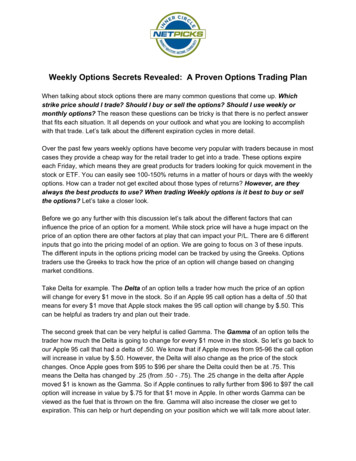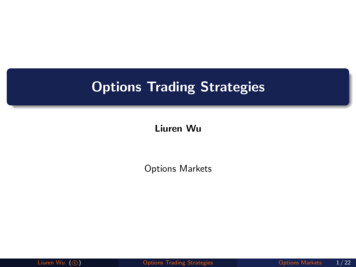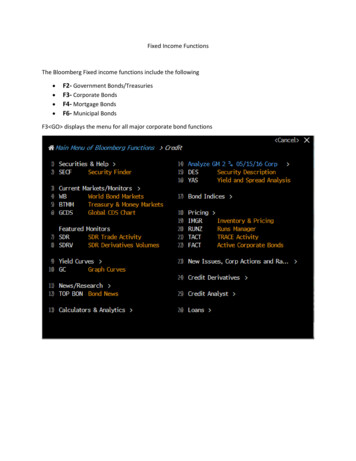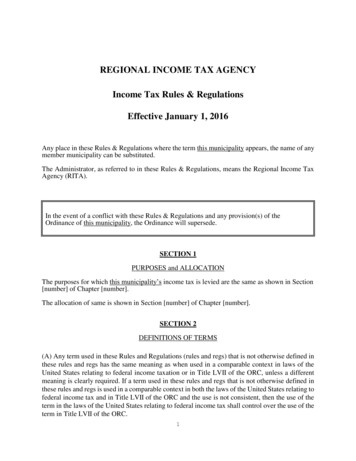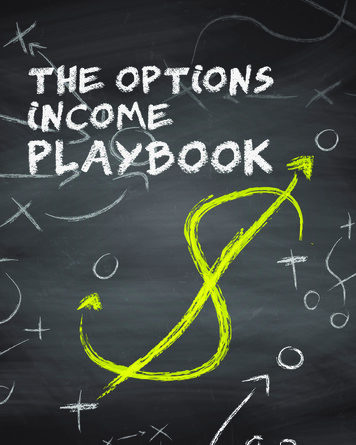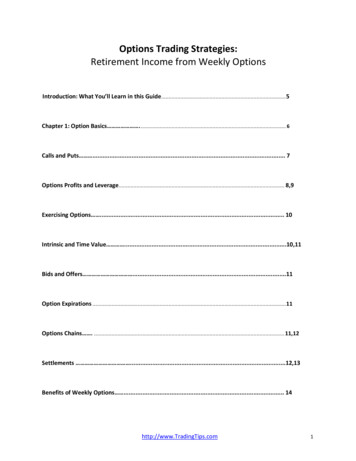
Transcription
Options Trading Strategies:Retirement Income from Weekly OptionsIntroduction: What You’ll Learn in this Guide. 5Chapter 1: Option Basics . . 6Calls and Puts . 7Options Profits and Leverage. 8,9Exercising Options . 10Intrinsic and Time Value .10,11Bids and Offers .11Option Expirations . 11Options Chains . . 11,12Settlements .12,13Benefits of Weekly Options . 14http://www.TradingTips.com1
Important Things to Remember . 14Chapter 2 Writing Options . 12Covered and Naked Calls . 15Why Sell Covered Calls .15,16Naked Calls . . 17Important Things to Remember . 17Chapter 3 Greeks .18Delta,Vega Gamma, Theta and Rho. 18,19Option Pricing . .20Implied Volatility .20Important Things to Remember . 21Chapter 4 Credit Spreads . .22Bear Call Spread. . . 22,23http://www.TradingTips.com2
Bull Put Spread .24The Benefits of Credit Spreads . 25Important Things to Remember . 25Chapter 5 Trading Credit Spreads .26Trading Bull Put Spreads .27Trading Bear Call Spreads . 28Determining Adequate Liquidity .29Lack of Volatility .29Important Things to Remember . 25Chapter 5 Trading Credit Spreads .26Trading Bull Put Spreads .27Trading Bear Call Spreads . 28Credit Spread Strategies. . 29http://www.TradingTips.com3
How to Choose the Right Credit Spread . 30The Delta of the Credit Spread .31The Wideness of the Credit Spread . 31Risk Management .32Stop Loss and Take Profit. .33Support and Resistance / Trend Lines . 34Specific Trades .35- 40Important Things to Remember . 40Apendix . 41Bollinger Bands, MACD and RSI. 41- 43http://www.TradingTips.com4
IntroductionOptions continue to grow at a very sharp pace as investor become aware of their enormouscapabilities. With options, an investor can profit during trending markets as well as sidewaysmarkets, and can provide insurance for a portfolio of stocks, commodities and even currencies.This guide will focus on a number of specific trading strategies, but prior to diving into thesestrategies, we will discuss calls and puts, which can be either short or long. That is correct,you can have a long call or a short put, a short call or a long put, and by the time you arefinished reading this book, it will all make sense to you!Once you have the basics down, we will move on to credit spread strategies, which thebest income producing strategies available. If you are interested in creating a strategy thathas defined risk, produces profitable monthly cash flows, while performing well in allmarket conditions, then credit spreads are the right strategy for you.Every trader should be aware of these types of option trading strategies, because if you don’t,you risk being on the losing side of a game. In fact, historically, 80% of the options traded settleout of the money.Learning about options may seem like a daunting task at first. In many ways, it is like learninga new language. Fortunately, once you get a handle on this topic it will make sense.So read on and learn how you too can profit with credit spreads, and earn a safemonthly income with predetermine risk.http://www.TradingTips.com5
Chapter 1: Option BasicsExchange- traded options, the subject of this guide, are contracts between two individuals: abuyer and a seller. There are options available for nearly every kind of financial security. Thereare options on foreign currencies, commodities, and even more sophisticated financialinstruments, such as weather, but this guide will deal exclusively with equity options, whichare options that give their owner the right to buy or sell shares of a stock at a specific price, onor before a certain date.Options are relatively new products when compared to stocks. Options, in their currentform, have only been around since 1973, and they have only gained their current level ofpopularity recently. For example, in 1999, the volume of options contracted traded in theU.S. stood at around 500 million a year, and by 2013 that number has increased 8 fold.The options industry notched its second- heaviest volume year in 2013, helped by stronggains in options tied to benchmark indexes. Trading volumes grew 2.7% in 2013 to 4.1 billioncontracts, with a total of 1.2 trillion in options premium exchanging hands throughout theyear.Standardization is the key to making options widely accessible to individual investors.Whereas a real- estate deals for a particular house, is customized, a stock option contractdeals with 100 shares of a given stock, for which there are millions exactly alike.http://www.TradingTips.com6
Call and PutsIn this section we will introduce a number of definitions that will help you become familiarwith options.A call option is a derivative security that gives the option buyer the right but not theobligation to purchase an underlying stock on or before a specific date.A put option is a derivative security that gives the buyer the right but not the obligation tosell or short a stock on or before a specific date.When an option is converted into the underlying stock, it is said to be exercised.The strike price of an option can be defined as the price at which the holder of an option canpurchase (in the case of a call option) or sell (in the case of a put option) the underlyingstock when the option is exercised.The price of the option or value of the option is referred to as the premium. The date when anoption is no longer active is called the expiration date. American style options ca be exercisedon or before the expiration date. European style option can only be exercised on the expirationdate a.Option ContractsOptions trade in contracts. Each options contract provides the owner the right to purchase 100shares of the underlying stock. When an investor purchases one option contract for 1 they arein fact paying for 1 for each share they have the right to purchase. In this case, one contractwould cost an investor 100 dollars ( 1 * 100 shares).An investor who owns one put contract has the right but not the obligation to sell or short100 shares of the underlying stock.http://www.TradingTips.com7
Option ProfitsOption prices fluctuate like stocks with market sentiment on daily basis. When the price of theunderlying security is above the strike price of a call option, the option is “in the money”. Ifthe underlying security is below the strike price of a put option the put is “in the money”.If the underlying price of the security is equal to the strike price of a call or put option, theoption is “at the money”. If an option is under water, the option is to be “out of the money”.For example if the strike price on a call option for XYZ stock is 25 and the underlying priceof XYZ stock is 23, the call option is “out of the money”.LeverageOne of the most apparent advantages of trading options is leverage. Leverage is the ability toincrease the amount of capital you risk, without having to pony up the funds. As discussedearlier, each option contract controls 100 shares of the underlying stock. The higher the stockprice, the more value the option controls.For example, if a trader purchases one call option of Apple, with a strike price of 600, whenthe price of the stock is 600, the option contract theoretically controls 100 shares * 600which equates to a notional value of 60,000. Obviously, the owner of a call option would paya premium for this type of control, but the amount paid is a fraction of the capital that iscontrolled.http://www.TradingTips.com8
The price of an Apple May 600 calls is 1.24 which means that an investor would pay 1.24 *100 124 dollars for the right to purchase 100 shares of Apple at 600 dollars a share. Thiswould allow the investor to use 124 to control 60,000 dollars of Apple stock. As you can see,the leverage is substantial. For every dollar used to purchase the option, a trader controls 484dollars ( 60,000 / 124)The profits can also be substantial when using options, but when purchasing options the riskis limited to the premium. Many traders use options as a way to pump up their ability to hithome runs on trades where the amounts are substantial, while the risks are limited to thepremiums. Of course, using options in such an aggressive manner amounts to little more thangambling.For example, the Apple 600 call discussed above shows a price of 1.24 when the price ofApple stock was 565. If the price moved to 610 prior to the expiration date of the option, thevalue of the option would be at least 10. While owning the stock would allow an investor toachieve a gain of nearly 8% ( 610 - 565) / 565, by purchasing the call the investorachieves a return of 700% ( 10 - 1.24) / 1.24.Leverage on options change based on a few factors. The most important is the distance thestrike price is from the current underlying price of the stock. The 565 option which was at themoney, cost 9.80 per option contract. While 980 controlling 56,500 is substantial, it is notnearly has high as 1.24 controlling 60,000. This occurs because the price of an option willincrease as the strike price of the option moves closer to the money or further into the money.Since it is more likely that an option with a strike price of 565 will be in the money ascompared to an option with a strike price of 600, the premiu
Every trader should be aware of these types of option trading strategies, because if you don’t, you risk being on the losing side of a game. In fact, historically, 80% of the options traded settle out of the money. Learning about options may seem like a daunting task at first. In many ways, it is like learning a new language. Fortunately, once you get a handle on this topic it will make .

